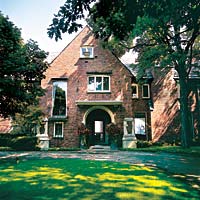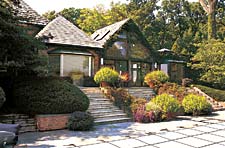|
|
In happier and wealthier days, the insurance titan Michael Segal lived at least part of the time on one of the most spectacular estates on the North Shore, a Lake Michigan property rich in architectural and historical associations. But following a dramatic run-in with the law, Segal has been forced to surrender the estate, which now sits on the market with a $22-million price tag-and a looming battle over its subdivision that pits preservationists against the federal government, which has seized the property. Paradoxically, the government’s desire to unload the estate with no strings attached may keep the land from being overrun by a cluster of new megahomes.
The story began to unfold in June 2004 following Segal’s conviction for looting millions of dollars from a trust fund maintained by his company, the clout-heavy Near North Insurance Brokerage. Segal was forced to give up control of his company and ordered to forfeit $30 million. The government hopes to recover some of that money from the sale of the Highland Park home.
|
|
Set on 17 lakefront acres, the property is a splendid relic from the golden age of the North Shore’s country estates. Built in 1921 for the stockbroker A. G. Becker, the 17-room house was designed by Howard Van Doren Shaw, at the time one of the nation’s premier residential architects. Subsequent owners dramatically altered the home, replacing the vintage multipane windows with floor-to-ceiling glass and eliminating most of the molding, wainscoting, and other interior architectural details. After Segal acquired the property in 1980, he put an addition on the back of the house that is a poor match for the original structure.
The estate’s crowning glory is the land. The magnificent grounds, designed by the great Prairie school landscape architect Jens Jensen, were primarily responsible for winning the place a spot on the National Register of Historic Places. Jensen installed sumptuous formal gardens, rustic stone footbridges, and a large meadow filled with indigenous plants, his signature touch. Preservationists credit Segal for restoring the grounds, which are among the best Chicago-area specimens of Jensen’s work.
“It’s one of the few grand estates that have not been subdivided,” says Danny Kahn, the chairman of Highland Park’s historic preservation commission. “The estates really began the North Shore, but now most of them are gone. This one is still undivided, and it also happens to be one of the most magnificent examples of Jensen’s work-and it survives pretty much like it was.”
 |
 |
|
A preservationist calls the estate “one of the most magnificent examples of [Jens] Jensen’s work”-a reference to the famed Prairie school landscape architect who laid out the property. |
|
Kahn and others hope that the property will remain intact, but ever since the U.S. Marshal seized it, the threat of subdivision has hung over the place. Margie Brooks, who is marketing the house for the feds (along with her fellow Baird & Warner agents Geri Katz Emalfarb, Debra Miller, and Debbie Scully), estimates that another ten houses could go up on the property if it was subdivided, each of them a multimillion-dollar home that would easily recoup for a developer the cost of the land while yielding a hefty profit.
The rub is that the U.S. Marshal and U.S. district judge Ruben Castillo have stipulated that they will accept no offers that come with contingencies attached. That means a developer who wants to buy the property contingent on being able to subdivide it would be rejected, says Melody Waldron, a supervisory deputy in the marshal’s Chicago office. “We get court orders to seize properties and get rid of them,” she said. “We generally sell a property without any contingencies, because we just need to get rid of it.” That means a developer who wanted to build on the property would have to buy it outright and accept the risk that the City of Highland Park might ultimately prohibit subdivision of the land.
|
|
That’s a big risk, and a costly one, though “the city has not taken a position on whether the property can be further divided, and it has not been asked to,” says Steven Elrod, Highland Park’s corporation counsel.
In August, city officials did begin the three-step process of declaring the property a landmark. The feds initially tried to stop the process, worried that it would undercut the property’s value, but agreed to postpone any attempts to thwart the plan in court pending an attempt to work out a deal with the City of Highland Park. At press time, a hearing to resolve the dispute had been rescheduled, after two postponements, for October 12th.
Kahn, whose preservation commission would oversee one step in the process, says landmark status would limit the scope of any potential alterations. “Subdivisibility then becomes dependent on not marring the historic nature of the property, which is going to severely restrict what can be done to that land,” he says. “We have made it very clear-and I believe the real-estate agents are spreading the word-that it would be extremely reckless of a developer to buy it at a [high] price and assume he could subdivide.” That said, Kahn does acknowledge that the commission, which he says takes a “negative” view toward any plan for subdivision, might accept one that included some public access to the historic landscape.
For the moment, says Baird & Warner’s Brooks, individual buyers, rather than developers, have expressed greater interest in the property. At least a dozen people toured the house this past summer within the first month of its going on the market, and the sales agents received one offer, though it was rejected. “It wasn’t in the price range it needed to be in,” Waldron said. “It was under $15 million; it needs to be closer to the asking price.” Castillo, who will have the ultimate say on a sale, declined to comment. Brooks says the offer remains on the table, should the feds change their minds. “Our job is to get the most we can for it,” she says, adding that if a plan to subdivide the property were approved “developers would pay the top [price].”
As for Mickey Segal, he now makes his home in the Loop at the Metropolitan Correctional Center. More than a year after his conviction, he still awaits sentencing, which may depend on the outcome of a mental competency examination. Prosecutors say the 62-year-old Segal could spend from 30 years to life in prison for his crimes.





